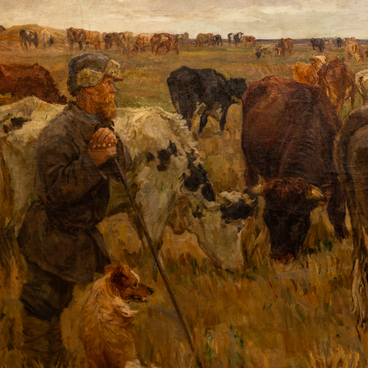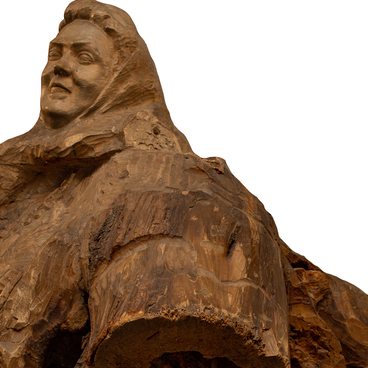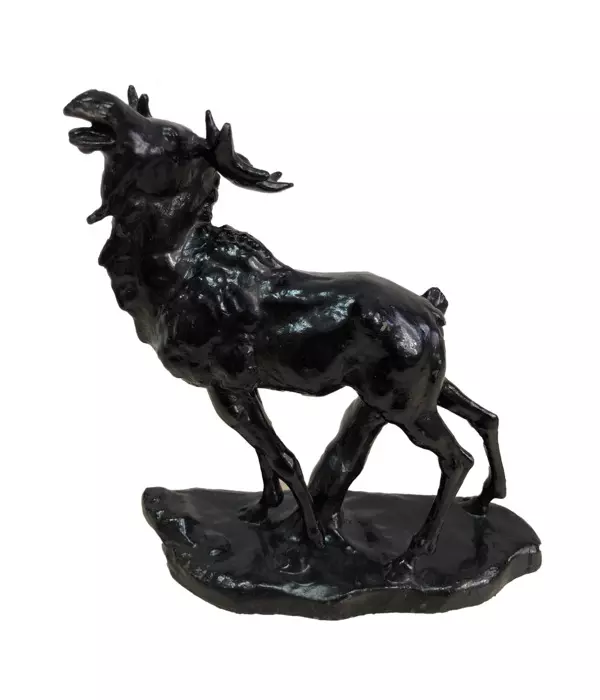The post-war Soviet art experienced a reinterpretation of genres. Landscapes and animalistic art gained particular interest. With these reinvented subject matters, there were also new opportunities for sculptors who began using animal statues to decorate buildings, city squares, bridges and terraces. Indoor sculpture became one of the most demanded types of art at exhibitions.
During that time, many artists traveled to the northern regions of Russia. For austere style artists, who sought to achieve monumentalism and severity in their works, the North with its pristine purity became their favorite subject matter. They also regarded the images of animals as a kind of a universal representation of the world.
Anatoly Anisimov was a famous animalier sculptor from the Ural region. In this statue, he showed two large moose in an arduous struggle with nature. The artist portrayed the severe weather conditions of the North very realistically: the moose seem to be stuck in a large snowbank during a fierce snowstorm. They struggle against a strong gust of wind and attempt to find their way through the icy snowdrift hindering their movements. The animals represent great strength, endurance and dignity.
This statue is the only work by Anisimov dedicated to the Russian North. Experts do not even know for sure whether the artist ever visited the region. It is known that he traveled across the Ural region, but there are no records of his trips to the North. In fact, not much is known about the sculptor’s biography: there are no monographs, catalogs, or even articles about Anisimov. However, judging by the number of works he created in the 1950s — 1960s, it can be said that the master made this statue during a very prolific period.
Anisimov became an animalier somewhere in the early 1950s — after that, he started creating statues of moose, deer and other animals. Many Soviet people were familiar with his porcelain statue of bear cubs. However, Anisimov’s most famous works are the dignified-looking deer and moose made of cast iron. People knew and admired these statues, and cast-iron moose became a kind of Anisimov’s trademark. The marble moose statue in the museum collection is one of a kind.
During that time, many artists traveled to the northern regions of Russia. For austere style artists, who sought to achieve monumentalism and severity in their works, the North with its pristine purity became their favorite subject matter. They also regarded the images of animals as a kind of a universal representation of the world.
Anatoly Anisimov was a famous animalier sculptor from the Ural region. In this statue, he showed two large moose in an arduous struggle with nature. The artist portrayed the severe weather conditions of the North very realistically: the moose seem to be stuck in a large snowbank during a fierce snowstorm. They struggle against a strong gust of wind and attempt to find their way through the icy snowdrift hindering their movements. The animals represent great strength, endurance and dignity.
This statue is the only work by Anisimov dedicated to the Russian North. Experts do not even know for sure whether the artist ever visited the region. It is known that he traveled across the Ural region, but there are no records of his trips to the North. In fact, not much is known about the sculptor’s biography: there are no monographs, catalogs, or even articles about Anisimov. However, judging by the number of works he created in the 1950s — 1960s, it can be said that the master made this statue during a very prolific period.
Anisimov became an animalier somewhere in the early 1950s — after that, he started creating statues of moose, deer and other animals. Many Soviet people were familiar with his porcelain statue of bear cubs. However, Anisimov’s most famous works are the dignified-looking deer and moose made of cast iron. People knew and admired these statues, and cast-iron moose became a kind of Anisimov’s trademark. The marble moose statue in the museum collection is one of a kind.




